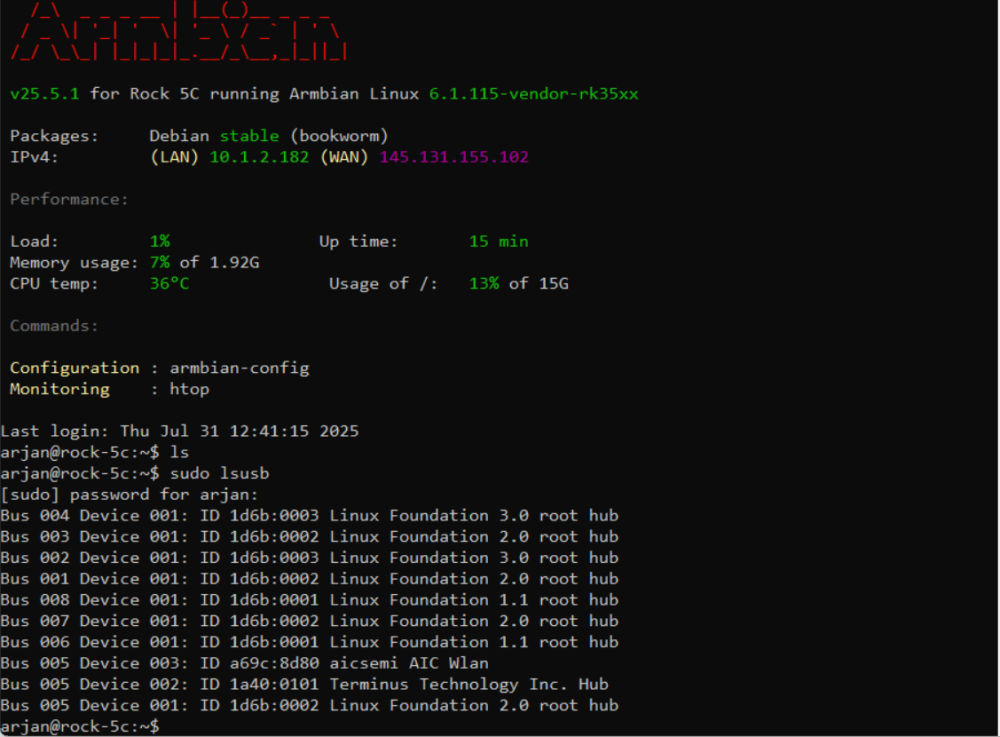Active threads
Showing topics posted in for the last 365 days.
- Past hour
-
Aliexpress randomly assembled electronics is expected to fail - you need to lower expectations, count on luck, read forum for clues, DIY. Little better are single board computers, then what is declared as supported, best what is platinum supported (for this use case FriendlyElec R3S would be perfect) following by Raspbbery Pi and x86 hardware. If you are looking for top first time experience buying a server, you should stick to https://www.supermicro.com/en/ I can assure you that Armbian works perfectly on any of servers they sell. But yes, price does not match.
- Today
-
up all night, finally got it working. list of stuff I did: download latest 2505 bookworm-xfce and reburn the u-us card 3 times. copied 40 entry /etc/hosts file from working machine. edit /etc/hostname to change it to unique name amanda, then make it immutable as that did not survive a reboot. rm 10-* in etc/netplan, rename armbian.yaml to 10-armbian.yam editing it as needed, and edit /etc/nsswitch.conf to make network setup start as "hostname files dns" rebooting after each stage. So hostname now stays at amanda, and nsswitch.conf works as ordered. I can ping yahoo.com in addition to my other local machines and have now updated 208 pkgs. rebooted looks ok. Now I can get back to making a 20T lvm out of 5 4T SSD's, But first some breakfast and a shot of insulin, and a nap while the local weather settles, its poured piss out of a cowbarn boot most of the night. Thank you for the links, they were educational.
-
I can confirm: https://paste.armbian.de/oxupahozud
-
@Mike H This is a community forum, and your message is for everyone. Armbian maintainers are part of this community, but please keep in mind that support here is provided on a best‑effort basis by volunteers and maintainers who give their time when they can. In open‑source projects, especially those maintained by communities, work is prioritized based on available time, skills, and resources. Sometimes an issue might be addressed quickly; other times it may take months — or it may not be addressed at all if the effort required is too great compared to the benefit. This is a normal reality in community‑driven software development. The concept of sunk cost often plays a role in deciding whether to invest effort in fixing certain issues. It’s worth noting that even in large, well‑funded projects, some bugs remain unresolved for years. In our case, resources are far more limited — for example, Raspberry Pi OS has a budget exceeding €1M annually for one platform, while Armbian supports many platforms with a fraction of that funding, outside few boards we have some small maintaining budget, there is only a beer money, and far fewer people. Best-effort is the only promise that can be provided under such circumstances. We appreciate bug reports, even they have nothing to do with our work as we understand users often can't judge that, but we ask that no pressure be placed on contributors to resolve them on demand. In some cases, solving an issue can take weeks or even months of work, which is not something users can reasonably expect from volunteers. And there are thousands of bugs already in the to do list. Finally, please understand that part of the challenge we face is that some projects already monetize or re‑brand our work while presenting it as inexpensive and easy to maintain — when in reality, it’s not. This can create misunderstandings about the real cost and effort behind keeping a complex software stack running. Your report is welcome, but we ask for patience, understanding, and respect for the time and resources of those trying to help. Pressuring volunteers to prioritize some issue, or expecting them to personally fund the work, is neither reasonable nor effective way to fix bugs.
- Yesterday
-
Coming back to this... I'm not having any luck getting overlays to work, but I'll need to get out my serial logger to see what's wrong I guess. I'm trying to get the USB-C into host mode on my RockPi-S. I can do it by editing the rk3308-rock-pi-s.dtb file directly, but not using an overlay file. Here's the overlay file I've tried (usbc-host.dts): /dts-v1/; / { fragment@0 { target-path = "/usb@ff400000"; __overlay__ { dr_mode = "host"; }; }; }; and /dts-v1/; /plugin/; / { fragment@0 { target-path = "/usb@ff400000"; __overlay__ { dr_mode = "host"; }; }; }; Tried using: armbian-add-overlay usbc-host.dts as well as compiling the overlay to a .dtbo and adding the line directly into armbianEnv.txt No joy either way... Also, does anyone know why some .dtbo files also have the line /plugin/; below /dts-v1/; ?
-
There is no official support for offline work. You can try OFFLINE_WORK=yes but no clue if it still works.
-
I ordered a NVMe HAT and the SSD works fine now. Thank you. Regards
-
R-TV Box S10 I know this is an old topic but I am trying to get this S10 box going for a old colleague which updated and now no longer starts but stays in the animation and not booting into android. Cannot find any firmware download. Thanks in advance
-
The latest Linux kernel brings enhanced MediaTek Platform enablement, Rockchip performance, and more. Collabora contributed to this release with no less than 22 authored contributors! View the full article
-

Rock 5C (Lite) - Wifi is not working or driver not found
ajvuik replied to PHYO ZIN KHANT's topic in Radxa Rock 5C
-
resolution: https://github.com/armbian/build/issues/8400#issuecomment-3136454158
-

labwc (wayland) crashes on exit
robertoj replied to robertoj's topic in Software, Applications, Userspace
Yes. Correct. Start with an armbian minimal or xcfe image that you build, with linux edge. Then install all the compilation dependencies mentioned in https://github.com/labwc/labwc/wiki and https://github.com/swaywm/sway/wiki/Debian-10-(Buster)-Installation#install-wlroots Some are mentioned as indicated for raspberry, but I installed them as well Do not install the debian bookworm libwlroots10 !! (this old wlroots interferes with the wlroots that will be installed now) Do not install libelogind-dev (it tried to modify my initramfs, it messed up the boot process, I didnt actually need it) You need a meson compiler more recent than bookworm provides. Install the backports repo: https://backports.debian.org/Instructions/ $ sudo apt install meson/bookworm-backports $ meson -v 1.7.0 Getting the labwc source code, and building: $ sudo apt install foot seatd (a minimal xterm for wayland, and a "seat manager" (may not be needed)) $ git clone https://github.com/labwc/labwc $ cd labwc $ meson setup build <-check that you have at least the GLES2 or EGL renderer If not, check that you have these dependencies: libegl-dev, libegl1-mesa-dev, libgles2-mesa-dev, libgles-dev If xwayland is desired, install xwayland from the bookworm repo After installing extra dependencies, run reconfiguration: $ meson setup --reconfigure build You will notice that the labwc build process auto-downloads and compiles a recent wlroots Finally compile (it took less than 5 minutes in my orange pi zero 3) $ meson compile -C build If it finishes compiling, check that the produced labwc works with: $ ./build/labwc -s foot If there's an error about memory allocation, add to armbianEnv.txt "extraargs=cma=256M", then reboot To install globally: $ sudo meson install -C build Test by exiting the labwc folder: cd ~ $ labwc -s foot Tomorrow, I will continue installing a display manager and greeter that works with wayland... since I am trying to avoid X11, due to my SPI LCD driver But all of you who try getting labwc in bookworm, hopefully the meson install command does something that lets lightdm see it is available as an option (I started with a minimal image) -

Banana Pi M2 Ultra boot freezing trying to scan the EMMC
赵凌 replied to goosnarrggh's topic in Allwinner sunxi
Actually, on my board, this value can be set to either 1 or 4. Setting it to 4 provides a significant boost to read/write performance, while a value of 8 fails the test. -
When auto login is enabled, this is how it starts - its in "show all screens" mode. I don't know how to fix this - its some Gnome settings / it doesn't bother me as click of a mouse to the empty space solves it. I saw you are trying Debian variant. Here it might be better to stick to Ubuntu based - its more polished. Weird beep you are experiencing - I haven't tested this HW for awhile, but so far I didn't notice it. Dunno where that is coming from.
-
Thanks everyone. I went with another phone and distro (ubuntu touch) since i found a fully supported one.
-
As @Werner said and then just ask any specific questions you may have. Welcome to the Armbian community, @Sahil Usmani.
-
I've started using an MXQ-4K box as a file server, but writing files over the network is slow, with speeds in the 3-5 MB/s range. Reads cap out at the fast ethernet link speed (~11 MB/s). I don't believe there's a CPU, disc, or RAM bottleneck as the speeds are the same regardless of file size or transfer protocol as SMB, FTP, and WebDAV all give me the same speeds, and checking in htop, they are never at 100%. These speeds are also observed when downloading a file from another device on the local network using wget or aria2 while sshed into it, with faster speeds on other devices. As far as I can tell, iostat doesn't suggest high io wait times are the culprit. If it matters, I'm writing to an external USB HDD, but the write speeds are the same when writing to the SD card through the network, which makes me believe this is not an issue. If I write a ~1.0GB file using dd to the HDD while sshed into it with `dd if=/dev/random of=/mnt/disk/tmp.bin bs=64k count=16500 conv=fdatasync`, it gives a local disk speed of ~20 MB/s, which is more than enough to saturate the 100 mbps link. Has anyone else experienced similar results? Are the slow network speeds just a limitation of the onboard nic/hardware? I'm open to suggestions.
-
You are asking for help. Have you actually followed the guidance you were given, though? Have you been successful to compile an image for any target (virtual or otherwise)?
-
@Sandeep Please don't hijack / necro old threads. You have a completely different issue from the OP, this particular one was already solved. Please open a new thread and show the output of "cat /etc/apt/sources.list /etc/apt/sources.list.d/*.{list,sources}". Feel free to ping me there and I'll be happy to help.
- Last week
-
Thanks a lot, It works! I've bought the orange pi zero 2 rencently, with also the board version v1.5, but in my case it seems that "pull PC5 to GND" is still needed, which is written at wiki: I use the latest Armbian IoT based on Ubnutu: So it may have some variant? Whatever, as it says: "pull PC5 to GND", I used a 2pin jumper(header) to shortcut the pin13(PC5) and pin14 rather than pin13 and pin9, since they are next to each other, and it works! 🙂 So I posted here in case someone runs into the same issue.




